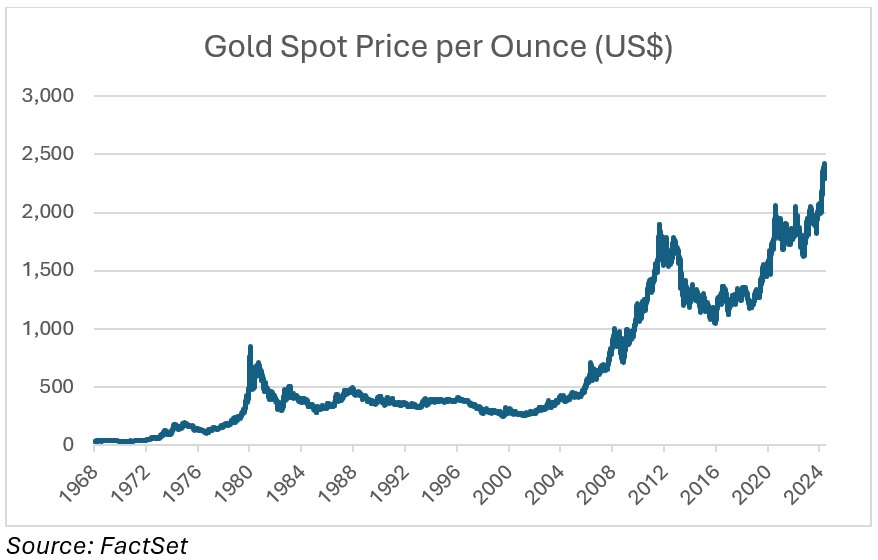Does Gold Belong in Your Retirement Plan?
There’s something sexy about a shiny gold bar, but should you go for the glitter? If you're tempted, a four-pronged investing approach could be best.


Gold has been in the headlines lately. Maybe you’ve noticed. I’m specifically talking about the shiny metal being sold by warehouse giant Costco. The bars are selling out within hours, if you can get them at all.
With so much enthusiasm around gold, it begs the question: Should gold be a part of your retirement plan?
Gold prices over the decades
It’s important to recognize how gold behaves. If you pull up a price chart that spans several decades, you’ll notice something. Gold has relatively short periods where it rockets up and then longer periods where it does nothing (or worse).
From just $107.88 $24.99 for Kiplinger Personal Finance
Become a smarter, better informed investor. Subscribe from just $107.88 $24.99, plus get up to 4 Special Issues

Sign up for Kiplinger’s Free Newsletters
Profit and prosper with the best of expert advice on investing, taxes, retirement, personal finance and more - straight to your e-mail.
Profit and prosper with the best of expert advice - straight to your e-mail.

If you’re an expert market timer, then you can obviously profit from buying during the uptrends and avoiding those long periods of underperformance. Unfortunately, during my time in this business, I’ve noticed something. There are very few investors who have even a remote shot at successfully timing the market. For most of us then, it’s the long term that we should concern ourselves with.
So how does gold do over the long term?
Here is one way to think about gold prices. Two hundred years ago, an ounce of gold could have afforded you one quality men’s suit. Today, that same ounce of gold will also buy you a high-quality men’s suit. In other words, it does a fantastic job of preserving purchasing power over the long term.
Physical gold has its plusses and minuses. There’s nothing quite like holding a bar of gold in your hand. And if we’re ever in some sort of doomsday scenario — the grid has collapsed, paper currency is worthless and so on, you’ll likely want your gold close at hand. Of course, hoarding coins and bars can make you a target for thieves. And since the IRS classifies physical gold as a collectible, you may be taxed at a steeper tax rate (currently as high as 28% on long-term gains) if you ever need to sell your gold.
Investing in gold without buying bars
Fortunately, there is more than one way to invest in gold. At SAM, we take a four-pronged approach. Part of that is owning physical gold, but there are three other categories that can benefit when the price of gold appreciates:
Major miners. Stocks of the largest companies that explore and produce gold, like Newmont Corp. (NEM) and Barrick Gold Corp. (GOLD), can be attractive at the right prices. They have operational leverage, meaning that while the price of gold rises, their costs stay the same, which can result in windfall profits when gold is a hot investment.
Emerging producers. This is the high-risk, high-reward part of the gold universe. Some of these companies don’t even produce gold. Rather, they are valued on their “pounds in the ground.” The lack of an operating history means these stocks carry greater uncertainty, but they can trade at a fraction of the value of their proven gold reserves.
Royalty companies. These are like banks for the mining industry. They provide capital to miners in exchange for a percentage of their production. Royalty companies have few employees and low overhead costs. When they’re not hunting for deals, they pretty much sit back and collect money. This superior business model has resulted in high profit margins and outstanding returns over time.
Is gold for you?
Whether you should own gold, how you should own it, and how much you should own ultimately depends on you and your financial goals. If capital preservation over the long term is a top priority for you, that argues for a larger allocation. But if you are growth- or income-driven, perhaps a small bit of exposure makes more sense for you. This sort of planning can be done on your own or with the assistance of a financial adviser.
Just know that if Costco is yet again out of stock or limits how many gold bars you can buy, you have many other options.
Related Content
- Disgusted With Your Savings Interest Rate? Time to Switch
- How to Find the Best Gold Stocks
- Why You Shouldn’t Ignore Investing in Commodities
- The Best Gold ETFs With Low Costs
- Why I Still Won't Buy Gold: Glassman
Profit and prosper with the best of Kiplinger's advice on investing, taxes, retirement, personal finance and much more. Delivered daily. Enter your email in the box and click Sign Me Up.

Michael is a Portfolio Manager and Deputy Chief Investment Officer at SAM, a Registered Investment Advisor with the United States Securities and Exchange Commission. File number: 801-107061. He sources investment opportunities and conducts ongoing due diligence across SAM’s portfolios. Michael co-manages SAM’s Income and Tactical Select strategies. Prior to joining SAM, Michael worked with high-net-worth private clients for the largest independent wealth management firm in the United States. He was also a senior analyst for one of the largest investment-grade bond managers in America. Michael joined SAM in 2017.
-
 Santa Claus Rally at Risk as Tech Stocks Slump: Stock Market Today
Santa Claus Rally at Risk as Tech Stocks Slump: Stock Market TodayThe Nasdaq Composite and Dow Jones Industrial Average led today's declines as investors took profits on high-flying tech stocks.
-
 7 Ways to Save Money on Almost Everything
7 Ways to Save Money on Almost EverythingHigh prices got you down? These strategies can help you reap deep discounts on everyday spending.
-
 My Top 10 Stock Picks for 2026
My Top 10 Stock Picks for 2026Each year, we ask an expert to pick 10 stocks that have the potential to beat the market over the next 12 months. Here are his choices for 2026.
-
 Now That You've Built Your Estate Planning Playbook, It's Time to Put It to Work
Now That You've Built Your Estate Planning Playbook, It's Time to Put It to WorkYou need to share details with your family (including passwords and document locations) and stay focused on keeping your plan up to date.
-
 I'm a Wealth Adviser: These 10 Strategies Can Help Women Prepare for Their Impending Financial Power
I'm a Wealth Adviser: These 10 Strategies Can Help Women Prepare for Their Impending Financial PowerAs women gain wealth and influence, being proactive about financial planning is essential to address longevity and close gaps in confidence and caregiving.
-
 I'm a Financial Planning Pro: This Is How You Can Stop These 5 Risks From Wrecking Your Retirement
I'm a Financial Planning Pro: This Is How You Can Stop These 5 Risks From Wrecking Your RetirementYour retirement could be jeopardized if you ignore the risks you'll face later in life. From inflation to market volatility, here's what to prepare for.
-
 Are You Hesitating to Spend Money You've Spent Years Saving? Here's How to Get Over It, From a Financial Adviser
Are You Hesitating to Spend Money You've Spent Years Saving? Here's How to Get Over It, From a Financial AdviserEven when your financial plan says you're ready for a big move, it's normal to hesitate — but haven't you earned the right to trust your plan (and yourself)?
-
 Time to Close the Books on 2025: Don't Start the New Year Without First Making These Money Moves
Time to Close the Books on 2025: Don't Start the New Year Without First Making These Money MovesAs 2025 draws to a close, take time to review your finances, maximize tax efficiency and align your goals for 2026 with the changing financial landscape.
-
 Is Fear Blocking Your Desire to Retire Abroad? What to Know to Turn Fear Into Freedom
Is Fear Blocking Your Desire to Retire Abroad? What to Know to Turn Fear Into FreedomCareful planning encompassing location, income, health care and visa paperwork can make it all manageable. A financial planner lays it all out.
-
 How to Master the Retirement Income Trinity: Cash Flow, Longevity Risk and Tax Efficiency
How to Master the Retirement Income Trinity: Cash Flow, Longevity Risk and Tax EfficiencyRetirement income planning is essential for your peace of mind — it can help you maintain your lifestyle and ease your worries that you'll run out of money.
-
 I'm an Insurance Expert: Sure, There's Always Tomorrow to Report Your Claim, But Procrastination Could Cost You
I'm an Insurance Expert: Sure, There's Always Tomorrow to Report Your Claim, But Procrastination Could Cost YouThe longer you wait to file an insurance claim, the bigger the problem could get — and the more leverage you're giving your insurer to deny it.